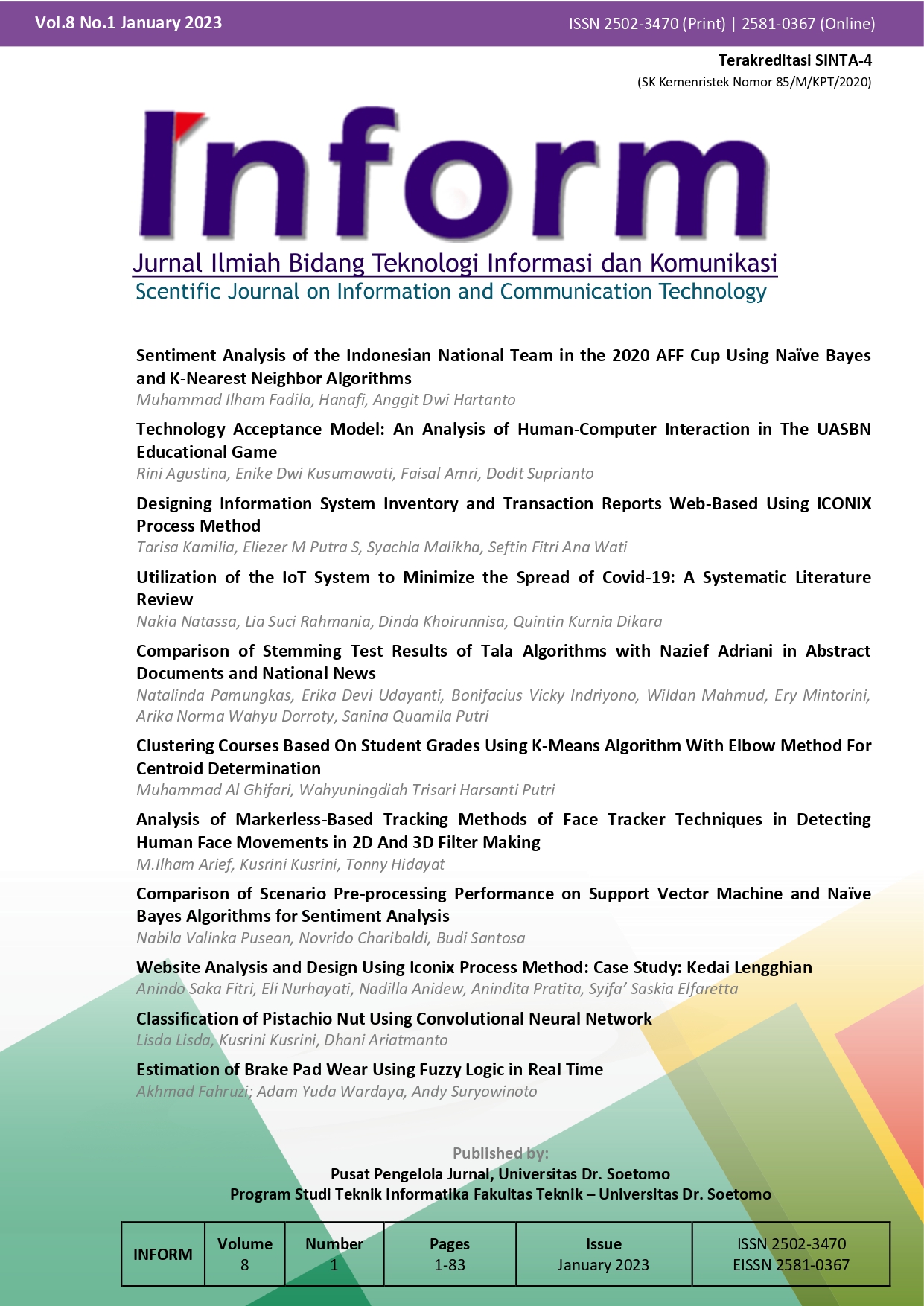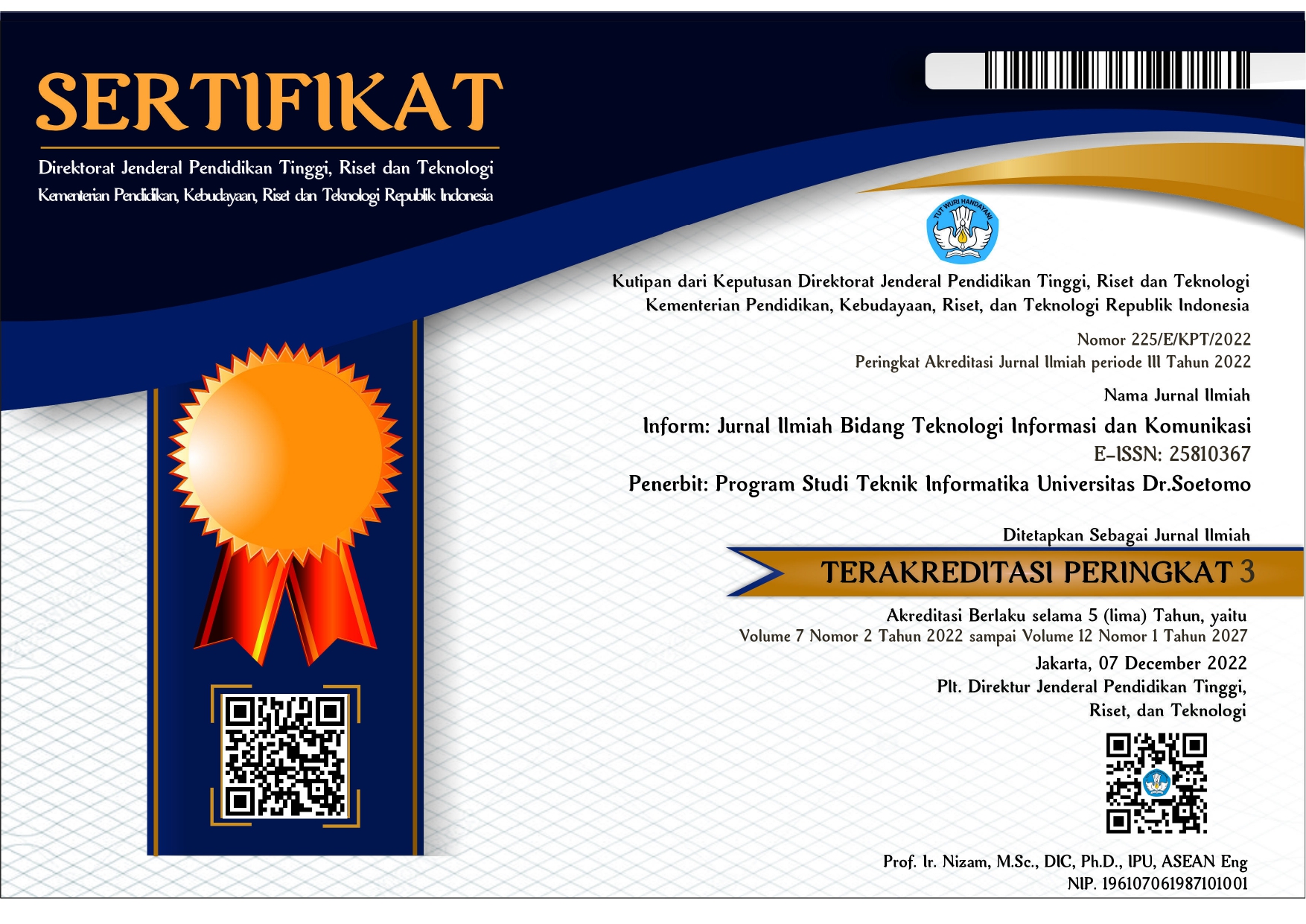Analysis of Markerless-Based Tracking Methods of Face Tracker Techniques in Detecting Human Face Movements in 2D And 3D Filter Making
 Abstract views: 372
,
Abstract views: 372
,
 PDF downloads: 287
PDF downloads: 287
Abstract
The marker-based tracking method is a method that utilizes markers, while the markerless-based tracking method is a method that does not use markers in making AR. In the markerless-based tracking method, there is a face tracker technique. In previous research, no one has discussed the comparison of effectiveness concerning the success and accuracy of using the face tracker technique. Therefore, this study aims to test the effectiveness of the accuracy and accuracy of success with applying the markerless-based tracking method, the face tracker technique, in detecting facial movements. in 2D and 3D AR with light intensity test parameters of 20 Lux, 40 Lux, and 60 Lux with WRGB light color, Face angle position of 30o and 60o, and face distance from camera 50 cm, 100cm, and 150cm. The results of comparison of superior success accuracy are at a distance of 50 cm; with an accuracy rate for 2D AR of 93.22% and 96.63% for 3D. It was concluded that the face tracker technique's markerless-based tracking method works optimally in 3D compared to 2D. This research finds an attractiveness score of 1.865, a perception score of 1.683, an efficiency score of 1.550, a dependability score of 1.638, a stimulation score of 1.500, and a novelty score of 1.013. Quality with an attractiveness value of 1.68, pragmatic quality of 1.56, and hedonic quality of 1.26. This study concludes that 2D and 3D AR face detection positively evaluates user experience and quality.
References
L. H. Ho, H. Sun, and T. H. Tsai, "Research on 3D painting in virtual reality to improve students' motivation of 3D animation learning," Sustainability (Switzerland), vol. 11, no. 6, 2019, doi: 10.3390/su11061605.
P. Diah, “KONSEP AUGMENTED REALITY DAN MOBILE MARKETING SEBAGAI USAHA PENGEMBANGAN PARAWISATA YOGYAKARTA DI ERA PANDEMI COVID 19,” 2021.
Y. Chen, Q. Wang, H. Chen, X. Song, H. Tang, and M. Tian, "An overview of augmented reality technology," in Journal of Physics: Conference Series, Jul. 2019, vol. 1237, no. 2. doi: 10.1088/1742-6596/1237/2/022082.
Nurhadi and Mulyadi, “Rancang Bangun Aplikasi Augmented Reality Berbasis Face Tracking untuk mendeteksi Wajah Peserta Wisuda,” 2018.
M. E. Apriyani et al., “Analisis Penggunaan Marker Tracking Pada Augmented Reality Huruf Hijaiyah,” Jurnal Infotel, vol. 8, no. 1, 2016.
R. Gusman, M. Eka Apriyani, J. Teknik Informatika, P. Studi Teknik Multimedia dan Jaringan, P. Negeri Batam, and J. Ahmad Yani, “Analisis Pemanfaatan Metode Markerless User Defined Target Pada Augmented Reality Sholat Shubuh,” Jurnal Infotel, vol. 8, no. 1, 2016.
M. Hasyim, N. Rokhmatulloh, M. Imron Rosadi, F. Arief Zakaria, U. Yudharta Pasuruan, and S. Artikel, “Jurnal Explore IT|28 Implementasi Teknologi Augmented Reality Sebagai Media Pembelajaran Bahasa Arab Berbasis Android Menggunakan Metode Markerless Tracking INFO ARTIKEL ABSTRAK,” 2021, doi: 10.35891/explorit.
M. Fernando, Android Augmented Reality . Buku AR Online, 2013.
Y. Taigman, M. Y. Marc', A. Ranzato, and L. Wolf, "DeepFace: Closing the Gap to Human-Level Performance in Face Verification," 2014.
K. Hazelwood et al., "Applied Machine Learning at Facebook: A Datacenter Infrastructure Perspective," in Proceedings - International Symposium on High-Performance Computer Architecture, Mar. 2018, vol. 2018-February, pp. 620–629. doi: 10.1109/HPCA.2018.00059.
A. Moin, L. Kolli, V. Sistla, V. Krishna, and K. Kolli, "International Journal of Computing and Digital Systems Planet Adventures: An Augmented Reality Game using Facial Emotion Recognition," 2021. [Online]. Available: http://journals.uob.edu.bh
D. K. Putra, A. Putra Aldya, R. N. Shofa, and A. P. Aldya, “Analisis Performa Marker 2D dan Marker 3D pada Augmented Reality Korespondensi,” Scientific Articles of Informatics Students, vol. 2, no. 1, pp. 60–68, 2019, [Online]. Available: https://publikasi.unsil.ac.id/index.php/sais
B. Arifitama, A. Syahputra, K. Bayu, and Y. Bintoro, “Analisis Perbandingan Efektifitas Metode Marker dan Markerless Tracking pada Objek Augmented Reality,” 2022.
W. Farianto, N. A. Prasetyo, and A. Raharja, “AUGMENTED REALITY OBJEK BERSEJARAH MUSEUM SOESILO SOEDARMAN MENGGUNAKAN METODE MARKER BASED DAN MARKERLESS,” 2021.
I. Andi, H. Asrul, Madi, Baharuddin, A. Muhammad, and Darmawati, “BUKU METODOLOGI,” 2018.
W. Ramadhan, B. Arifitama, and S. D. H. Permana, "Mobile augmented reality for furniture visualization using Simultaneous Localization and Mapping (SLAM)," IOP Conf Ser Mater Sci Eng, vol. 1098, no. 6, p. 062008, Mar. 2021, doi: 10.1088/1757-899x/1098/6/062008.
S. Putro, Kusrini, M. P. Kurniawan, and K. Kunci -Lapor Bantul, “Penerapan Metode UEQ dan Cooperative Evaluation untuk Mengevaluasi User Experience Lapor Bantul Implementation Methods of UEQ and Cooperative Evaluation to Evaluate User Experience Lapor Bantul,” Citec Journal, vol. 6, no. 1, 2019.
K. Kusrini, S. Suputa, A. Setyanto, I. Made Artha Agastya, H. Priantoro, and K. Chandramouli, "User Evaluation of Mobile based Smart Mango Pest Identification," 2020.
A. Muhammad, Y. Amak, and E. Alexius, "ANALISIS USER EXPERIENCEPADAAUGMENTED REALITYORGANOLOGY MENGGUNAKANUSER EXPERIENCE QUESTIONNAIRE (UEQ)," 2022.
K. Teguh Martono, "Analysis on User Experience Using UEQ Method in the Information System of Web-Based Child Development Monitoring," 2020. [Online]. Available: https://ssrn.com/abstract=3953323
Dr. Martin Schrepp, "User Experience Questionnaire Handbook," 2019. [Online]. Available: www.ueq-online.org
Copyright (c) 2023 Kusrini Kusrini, M.Ilham Arief, Tonny Hidayat

This work is licensed under a Creative Commons Attribution-ShareAlike 4.0 International License.
Authors who publish with Inform: Jurnal Ilmiah Bidang Teknologi Informasi dan Komunikasi agree to the following terms:
-
Authors retain copyright and grant the journal right of first publication with the work simultaneously licensed under a Creative Commons Attribution License (CC BY-SA 4.0) that allows others to share the work with an acknowledgment of the work's authorship and initial publication in this journal.
-
Authors are able to enter into separate, additional contractual arrangements for the non-exclusive distribution of the journal's published version of the work (e.g., post it to an institutional repository or publish it in a book), with an acknowledgment of its initial publication in this journal.
-
Authors are permitted and encouraged to post their work online (e.g., in institutional repositories or on their website) prior to and during the submission process, as it can lead to productive exchanges, as well as earlier and greater citation of published work.













